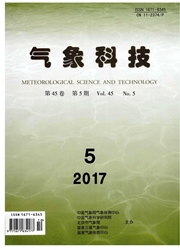

 中文摘要:
中文摘要:
利用2000—2013年莱州湾各气象站逐日降水资料、常规资料、海温资料及NCEP/NCAR再分析资料,对莱州湾冷流降雪的气候特征及成因进行了分析。结果表明:莱州湾降雪强度较小,中雪和大雪主要集中在莱州湾东部地区。降雪持续时间较短,一般在12h以内。冷流降雪次数呈现东部多西部少的特点,年际变化明显,存在显著的6-7a年际尺度的周期变化。1月是冷流降雪的主要月份,12月下旬至1月上旬是主要旬份。冷流降雪主要时段集中出现在08:00左右。近14年冷流降雪次数与同年份的冷空气次数存在显著的正相关。发生冷流降雪时850hPa及以下各层均有明显的温度阈值。莱州湾海温和海气温差过高或过低都不易出现冷流降雪。低于5℃为发生冷流降雪的地面2m温度阈值,该阈值明显高于内陆降雪的阈值。冷流降雪发生时,500hPa以槽后(含涡后)西北气流为主,700、850hPa都处在西北气流控制下,925、1000hPa为西北风、偏北风或东北风3种形势。
 英文摘要:
英文摘要:
Using daily precipitation data,conventional data,sea surface temperature data,and NCEP/NCAR reanalysis data from 2000 to 2013,the characteristics and causality of cold airflow snowfall in the Laizhou Bay are analyzed.The results show that the snowfall intensity is small,and the moderate and heavy snow are mainly concentrated in the eastern region of the Laizhou Bay.Duration of snowfall is short within 12 hours.Cold-airflow snowfall happens more frequently in the east and less in the west of the Laizhou Bay and their inter-annual variation are obvious.Marked periodic variation of 6to 7years is found.Cold-airflow snowfall often occurs in January,especially from the last ten-day of December to the first ten-day of January and mainly around 08:00in the morning.There is a positive correlation between the annual cold air activity index and the number of cold airflow snowfall events.There are obvious temperature thresholds at 850hPa levels during cold-airflow snowfall events.Cold-airflow snowfall happens less at too high or too low sea surface temperature and air-sea temperature difference over the Laizhou Bay,and the ground temperature threshold(at 2m)is below 5℃,which is higher than the inland snowfall threshold.Cold-airflow snowfall often happens in the northwest airflow behind a trough(including behind eddy)at 500 hPa and the northwest winds at 700 hPa and 850 hPa,and there exist three circumfluence situations:northwest,north,and northeast winds at 925 hPa and 1000 hPa.
 同期刊论文项目
同期刊论文项目
 同项目期刊论文
同项目期刊论文
 期刊信息
期刊信息
